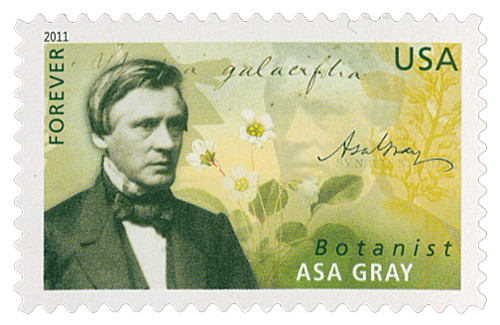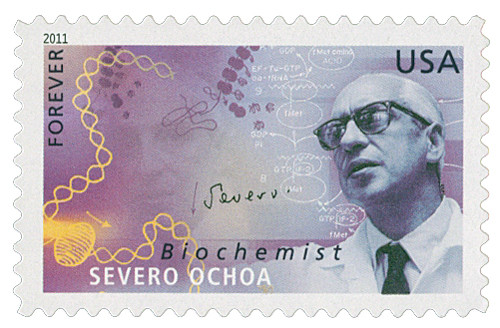
# 4541 - 2011 First-Class Forever Stamp - American Scientists: Melvin Calv
2011 44¢ Melvin Calvin
American Scientists
Birth of Melvin Calvin
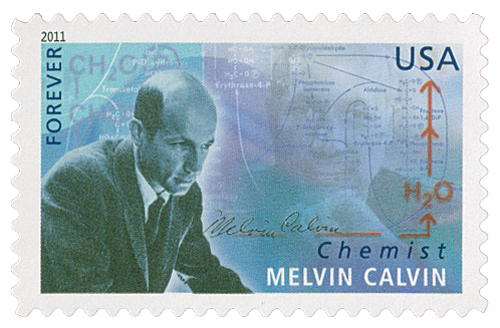
Biochemist Melvin Calvin was born on April 8, 1911, in St. Paul, Minnesota. He earned the 1961 Nobel Prize for Chemistry for his discover of the Calvin cycle – the conversion of carbon dioxide into organic molecules during photosynthesis.
Calvin’s family moved to Detroit when he was young and ran a small grocery store. He worked at the store when he wasn’t in school and grew interested in the different products they sold. Calvin wondered what things were made of and developed an interest in chemistry. A high school teacher once criticized him for not gathering all the data before arriving at his answers, and said he’d never make a scientist.

Years later, Calvin addressed the comments in his 1992 autobiography. He wrote, “It’s no trick to get the right answer when you have all the data. The real creative trick is to get the right answer when you have only half of the data in hand and half of it is wrong and you don’t know which half is wrong.”
Calvin went on to attend Michigan College of Science and Technology where he was the school’s first chemistry major. He then earned his Ph.D. from the University of Minnesota in 1935. After graduation, Calvin spent two years in England studying with Michael Polanyi. While there, he grew interested in photochemistry (studying the chemical effects of light), which sent him on the path to study chlorophyll, photosynthesis, and artificial photosynthetic membrane models.

Upon returning to the US in 1937, Calvin was hired to teach at the University of California at Berkeley. He was promoted to Professor of Chemistry in 1947 and remained at Berkeley until 1980. Calvin strongly encouraged cooperation among different scientific disciplines. The Berkeley bioscience lab nicknamed the “Calvin Carousel,” was officially named the Melvin Calvin Laboratory after he retired. Time magazine gave Calvin a different nickname – “Mr. Photosynthesis.”
Calvin’s creativity led to breakthrough research regarding photosynthesis, the process by which plants convert sunlight into energy. The conversion of carbon dioxide into organic molecules is called the “Calvin Cycle” (or the Calvin-Benson-Bassham Cycle) because of his work. Calvin received the 1961 Nobel Prize in Chemistry for his use of carbon-14 to determine how plants use carbon during photosynthesis.

Calvin, Andrew Benson, and James Bassham traced the full route that carbon travels through a plant during photosynthesis – from the time its absorbed as atmospheric carbon dioxide to its conversion to carbohydrates and other organic compounds. This study proved that sunlight, rather than carbon dioxide, affects chlorophyll in the production of organic compounds. His Nobel presenter credited Calvin with “the complete clarification of an extremely intricate problem.”
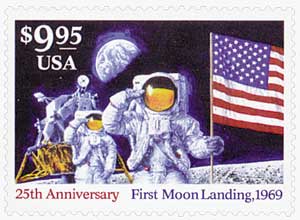
Calvin later helped found the Society for General Systems Research. He was also made a Professor of Molecular Biology and founded the Laboratory of Chemical Biodynamics. He served as director of that lab and associate director of the Berkeley Radiation Lab until his retirement in 1980. Calvin committed several years of research to studying the chemical evolution of life as well as possible uses of oil-producing plants for renewable energy. During his lifetime, he was made a foreign member of the Royal Netherlands Academy of Arts and Sciences and received an honorary Doctor of Laws from Whittier College.
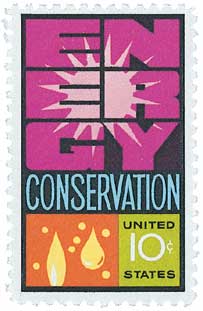
Calvin was also involved with NASA’s Apollo program. He provided plans to protect the Moon from biological contamination from the Earth, as well as protection for the Earth from lunar organisms. He also aided in the search for biological and organic elements on lunar samples and plans to continue that research on other planets. Calvin also served on the President’s Science Advisory Committee and served on the Department of Energy’s Energy Research Advisory Board. Calvin died on January 8, 1997.
2011 44¢ Melvin Calvin
American Scientists
Birth of Melvin Calvin

Biochemist Melvin Calvin was born on April 8, 1911, in St. Paul, Minnesota. He earned the 1961 Nobel Prize for Chemistry for his discover of the Calvin cycle – the conversion of carbon dioxide into organic molecules during photosynthesis.
Calvin’s family moved to Detroit when he was young and ran a small grocery store. He worked at the store when he wasn’t in school and grew interested in the different products they sold. Calvin wondered what things were made of and developed an interest in chemistry. A high school teacher once criticized him for not gathering all the data before arriving at his answers, and said he’d never make a scientist.

Years later, Calvin addressed the comments in his 1992 autobiography. He wrote, “It’s no trick to get the right answer when you have all the data. The real creative trick is to get the right answer when you have only half of the data in hand and half of it is wrong and you don’t know which half is wrong.”
Calvin went on to attend Michigan College of Science and Technology where he was the school’s first chemistry major. He then earned his Ph.D. from the University of Minnesota in 1935. After graduation, Calvin spent two years in England studying with Michael Polanyi. While there, he grew interested in photochemistry (studying the chemical effects of light), which sent him on the path to study chlorophyll, photosynthesis, and artificial photosynthetic membrane models.

Upon returning to the US in 1937, Calvin was hired to teach at the University of California at Berkeley. He was promoted to Professor of Chemistry in 1947 and remained at Berkeley until 1980. Calvin strongly encouraged cooperation among different scientific disciplines. The Berkeley bioscience lab nicknamed the “Calvin Carousel,” was officially named the Melvin Calvin Laboratory after he retired. Time magazine gave Calvin a different nickname – “Mr. Photosynthesis.”
Calvin’s creativity led to breakthrough research regarding photosynthesis, the process by which plants convert sunlight into energy. The conversion of carbon dioxide into organic molecules is called the “Calvin Cycle” (or the Calvin-Benson-Bassham Cycle) because of his work. Calvin received the 1961 Nobel Prize in Chemistry for his use of carbon-14 to determine how plants use carbon during photosynthesis.

Calvin, Andrew Benson, and James Bassham traced the full route that carbon travels through a plant during photosynthesis – from the time its absorbed as atmospheric carbon dioxide to its conversion to carbohydrates and other organic compounds. This study proved that sunlight, rather than carbon dioxide, affects chlorophyll in the production of organic compounds. His Nobel presenter credited Calvin with “the complete clarification of an extremely intricate problem.”

Calvin later helped found the Society for General Systems Research. He was also made a Professor of Molecular Biology and founded the Laboratory of Chemical Biodynamics. He served as director of that lab and associate director of the Berkeley Radiation Lab until his retirement in 1980. Calvin committed several years of research to studying the chemical evolution of life as well as possible uses of oil-producing plants for renewable energy. During his lifetime, he was made a foreign member of the Royal Netherlands Academy of Arts and Sciences and received an honorary Doctor of Laws from Whittier College.

Calvin was also involved with NASA’s Apollo program. He provided plans to protect the Moon from biological contamination from the Earth, as well as protection for the Earth from lunar organisms. He also aided in the search for biological and organic elements on lunar samples and plans to continue that research on other planets. Calvin also served on the President’s Science Advisory Committee and served on the Department of Energy’s Energy Research Advisory Board. Calvin died on January 8, 1997.







